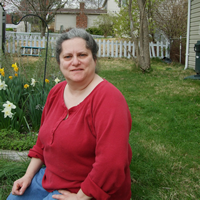People buy pretty apples. Deep color, glossy (too often from application of wax) not dull, no black or corky areas. In other words, not looking like these apples infected with apple scab fungus: http://orchard.uvm.edu/uvmapple/hort/src.html
Traditionally what has been done to combat apple scab has been to apply large quantities of fungicides to orchards every 10 days during the spring (and some in damp weather during the rest of the growing season). This is expensive both in cash costs to the grower (even more so if looking for organic options) and uses a significant amount of petroleum in manufacture, shipping, and spraying of the fungicide. Clearing leaf litter and such from the orchard to reduce overwintering of the fungus is used, too, but doesn't stop air born infestation from nearby areas.
Untreated, not only do folks not buy the apples, but the leaf damage by the fungus reduces yields and weakens trees. Thus, something needed to be done!
Here is where apple breeders stepped in. They have been working on developing scab-resistant apple varieties for decades.
Breeding apple trees is an incredibily long tedious job. They are 'extreme heretozygotes' ... that is ... uh .... okay, think of each apple variety as being one unique human being - see YOURSELF as an apple variety. (I'll bet you think of yourself as Delicious, unless your last name is MacIntosh.) For every trait you exhibit (hair color, eye color, height, shape of nose, whatever) you not only have a constellation of different genes controlling that trait, but for some of those genes you have the same gene from both parents and some you have different genes from both parents. Even if you figured out a way to breed yourself by yourself you would end up with another unique individual, incredibly different than you are. Apples are like that.
As a result, if you breed any apple flower by any other apple flower - even one on the same tree - you end up with seeds that don't produce that original type of apple. You get what were originally called 'pippens' - a mixed orchard in which some apples will be new and at least edible varieties but most will be apple that humans aren't very interested in. Maybe the taste will be off, maybe they'll be small, maybe they'll have very sharplyl angled branches that break easily, whatever. This is why apples are usually propagated by cuttings, which have a set genetic structure, and why most new apple varieties come from 'sports' - branches on an existing tree that have mutated and produce interesting new fruit.
Which brings us back to apple scab.
Waiting for some branch in some orchard to spontaneously develop resistant to apple scab is not what humans want, as it may never happen or not be noticed it if does. Instead, they have been working with the apple varieties and their constellation of traits working to help create new varieties that resist apple scab and have nice flavor/configuration/shipping/storage features as well. After decades of work by poor grad students (with the universities and professors taking the credit) they are having sucess and some new varieties are out on the market.
The most recent variety to be announced is the WineCrisp http://research.aces.illinois.edu/feature. It is NOT a GMO'd apple, it is a traditionally and laboriously bred apple with apple scab resistance. Apparently it's not a glossy apple, and is rock hard, but tastes good.
It is not the only apple that has been bred to resist apple scab. Here is a list, with useful evaluation notes, from the University of Vermont. I assume that the other PRI apples on the list aren't GMO, and don't have info on the apples from other research groups. http://orchard.uvm.edu/uvmapple/hort/src.html. Some have weak wood on the trees, some have small apples - you can bet that breeders are still having their grad students work away on new varieties or modifications of the extisting ones!
Some of these might be good for a home garden/small orchard, and will certainly reduce the amount of problems with scab/scab treatments you'll have to do.
But, until any of us try the scab-resistant varieties - what apple varieties are your favorites?
Thursday, April 9, 2009
Subscribe to:
Post Comments (Atom)

fascinating stuff, me love! my faves are grannies, just cuz nik likes 'em best and they pie well. i rarely eat apples for treats. i'll definitely look for the winecrisp. i much prefer a hard apple to a mushy one.
ReplyDeleteours are so tiny and riddled with the cedar/apple blight i can't even tell what variety they are. they're so tart that the fatties, who eat ANYTHING, are rather wary of them. but nik, who is suspicious of most treats, snarfs 'em up.
go figgah.
:) khairete
suz
Suz, some of the varieties resistant to scab are also resistant to Cedar Apple Rust - is that what your apples have?
ReplyDelete"Tiny Pale-yellow Spots on Leaves
Cedar Apple Rust - Cedar apple rust causes pale yellow, pinhead-sized spots on the upper surfaces of apple leaves. These spots enlarge and turn bright orange on foliage and fruit. This rust originates on nearby cedar trees, forming swellings, or galls, on their bark. Junipers and hawthorns can also spread cedar apple rust to apple trees. Spray apple trees with fungicide when cedar galls are releasing spores in the early spring. Remove all red cedar trees within 300 yards of the apple tree. Apple varieties resistant to Cedar Apple Rust include Liberty, Nova Easygro, Novamac, Priscilla, and Redfree. " from: www.gardening.yardener.com/SolvingAppleTreeProblems.html